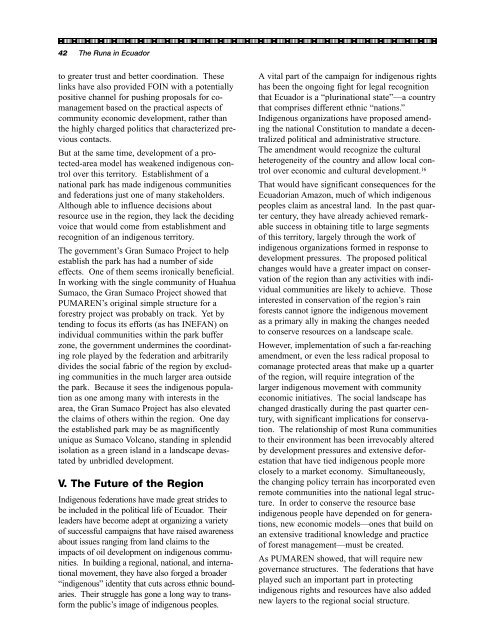Indigenous Peoples and Conservation Organizations
Indigenous Peoples and Conservation Organizations
Indigenous Peoples and Conservation Organizations
Create successful ePaper yourself
Turn your PDF publications into a flip-book with our unique Google optimized e-Paper software.
42 The Runa in Ecuador<br />
to greater trust <strong>and</strong> better coordination. These<br />
links have also provided FOIN with a potentially<br />
positive channel for pushing proposals for comanagement<br />
based on the practical aspects of<br />
community economic development, rather than<br />
the highly charged politics that characterized previous<br />
contacts.<br />
But at the same time, development of a protected-area<br />
model has weakened indigenous control<br />
over this territory. Establishment of a<br />
national park has made indigenous communities<br />
<strong>and</strong> federations just one of many stakeholders.<br />
Although able to influence decisions about<br />
resource use in the region, they lack the deciding<br />
voice that would come from establishment <strong>and</strong><br />
recognition of an indigenous territory.<br />
The government’s Gran Sumaco Project to help<br />
establish the park has had a number of side<br />
effects. One of them seems ironically beneficial.<br />
In working with the single community of Huahua<br />
Sumaco, the Gran Sumaco Project showed that<br />
PUMAREN’s original simple structure for a<br />
forestry project was probably on track. Yet by<br />
tending to focus its efforts (as has INEFAN) on<br />
individual communities within the park buffer<br />
zone, the government undermines the coordinating<br />
role played by the federation <strong>and</strong> arbitrarily<br />
divides the social fabric of the region by excluding<br />
communities in the much larger area outside<br />
the park. Because it sees the indigenous population<br />
as one among many with interests in the<br />
area, the Gran Sumaco Project has also elevated<br />
the claims of others within the region. One day<br />
the established park may be as magnificently<br />
unique as Sumaco Volcano, st<strong>and</strong>ing in splendid<br />
isolation as a green isl<strong>and</strong> in a l<strong>and</strong>scape devastated<br />
by unbridled development.<br />
V. The Future of the Region<br />
<strong>Indigenous</strong> federations have made great strides to<br />
be included in the political life of Ecuador. Their<br />
leaders have become adept at organizing a variety<br />
of successful campaigns that have raised awareness<br />
about issues ranging from l<strong>and</strong> claims to the<br />
impacts of oil development on indigenous communities.<br />
In building a regional, national, <strong>and</strong> international<br />
movement, they have also forged a broader<br />
“indigenous” identity that cuts across ethnic boundaries.<br />
Their struggle has gone a long way to transform<br />
the public’s image of indigenous peoples.<br />
A vital part of the campaign for indigenous rights<br />
has been the ongoing fight for legal recognition<br />
that Ecuador is a “plurinational state”—a country<br />
that comprises different ethnic “nations.”<br />
<strong>Indigenous</strong> organizations have proposed amending<br />
the national Constitution to m<strong>and</strong>ate a decentralized<br />
political <strong>and</strong> administrative structure.<br />
The amendment would recognize the cultural<br />
heterogeneity of the country <strong>and</strong> allow local control<br />
over economic <strong>and</strong> cultural development. 16<br />
That would have significant consequences for the<br />
Ecuadorian Amazon, much of which indigenous<br />
peoples claim as ancestral l<strong>and</strong>. In the past quarter<br />
century, they have already achieved remarkable<br />
success in obtaining title to large segments<br />
of this territory, largely through the work of<br />
indigenous organizations formed in response to<br />
development pressures. The proposed political<br />
changes would have a greater impact on conservation<br />
of the region than any activities with individual<br />
communities are likely to achieve. Those<br />
interested in conservation of the region’s rain<br />
forests cannot ignore the indigenous movement<br />
as a primary ally in making the changes needed<br />
to conserve resources on a l<strong>and</strong>scape scale.<br />
However, implementation of such a far-reaching<br />
amendment, or even the less radical proposal to<br />
comanage protected areas that make up a quarter<br />
of the region, will require integration of the<br />
larger indigenous movement with community<br />
economic initiatives. The social l<strong>and</strong>scape has<br />
changed drastically during the past quarter century,<br />
with significant implications for conservation.<br />
The relationship of most Runa communities<br />
to their environment has been irrevocably altered<br />
by development pressures <strong>and</strong> extensive deforestation<br />
that have tied indigenous people more<br />
closely to a market economy. Simultaneously,<br />
the changing policy terrain has incorporated even<br />
remote communities into the national legal structure.<br />
In order to conserve the resource base<br />
indigenous people have depended on for generations,<br />
new economic models—ones that build on<br />
an extensive traditional knowledge <strong>and</strong> practice<br />
of forest management—must be created.<br />
As PUMAREN showed, that will require new<br />
governance structures. The federations that have<br />
played such an important part in protecting<br />
indigenous rights <strong>and</strong> resources have also added<br />
new layers to the regional social structure.

















